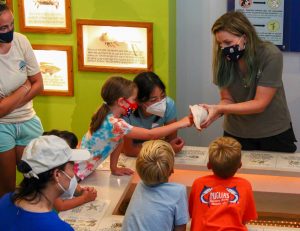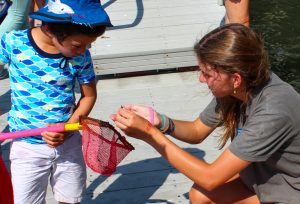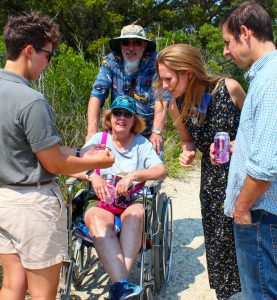by Brooke Knapick, Director of Educational Program Development

So much of what makes outdoor and environmental education impactful, and real, relies on the interaction of participant, educator and outdoor experience, all working in concert to create a genuine human connection to the environment. It is the sights, the smells, the sounds, the feelings, the immersion in the environment that creates connection, and it is the pursuit of fostering this connection that guides our life’s work. Duplicating this emotional and experiential connection in a virtual milieu seemed unfathomable. Many environmental education professionals began to wonder, is it even possible?
Replicating this exact emotional and experiential connection might not be possible, but innovating and creating an entirely new and equally profound virtual connection is possible. Challenging, yes, but possible; and with possibility comes opportunity for invention and growth in new and unexplored directions. – Brooke Knapick, Views From the Tower, Summer 2020
Fast forward a year from when I penned those words, and it is time for the rest of the story. Over the past 18 months, we have shared the successes and challenges of developing and implementing virtual and/or at-home alternatives for all of our program offerings from Summer Nature Program to Environmental Education Field Trip to Nature Education for Homeschool Students and Teachers (NEHST), and even Scout and Science Education at Sea (SEAS) programs. During that time, we have conducted over 35 virtual programs, and delivered over 135 at-home activity boxes, stretching the boundaries of what is possible and reaching nearly 1,865 individuals. On top of that, The Virtual Wetlands Experience continues to be a valuable resource, welcoming more than 9,100 visits to the webpage with 67% of visitors returning to the site more than once. However, despite these successes, the resounding sentiment from program participants is always: “It was beautifully done, but it is not the same as in person.”
 As the calendar turned to a new year, the weather warmed, and pandemic restrictions loosened, outdoor and environmental education began to experience a gradual return to in-person programs, a seemingly stark contrast to the abrupt transition to virtual programs just a year prior. Slowly but surely, educators and participants alike ventured out into a shared natural environment allowing for the interaction between participant, educator, and outdoor experience to begin anew. As the months continued on, the desire for immersive, tangible interactions in nature only grew stronger. Visitors returned to The Wetlands Institute doors in large numbers, Traveling Environmental Education and Group Outreach Programs conducted more programs than any summer season in recent memory, and Summer Nature Program experienced its highest enrollment in history, peaking at 96% capacity and serving over 525 children. Currently, momentum continues to build, with NEHST enrollments at 100% capacity for the Autumn Semester, Scout programs growing each day, and spring Environmental Education Field Trip and SEAS program bookings ushering in a return to in-person school field trips.
As the calendar turned to a new year, the weather warmed, and pandemic restrictions loosened, outdoor and environmental education began to experience a gradual return to in-person programs, a seemingly stark contrast to the abrupt transition to virtual programs just a year prior. Slowly but surely, educators and participants alike ventured out into a shared natural environment allowing for the interaction between participant, educator, and outdoor experience to begin anew. As the months continued on, the desire for immersive, tangible interactions in nature only grew stronger. Visitors returned to The Wetlands Institute doors in large numbers, Traveling Environmental Education and Group Outreach Programs conducted more programs than any summer season in recent memory, and Summer Nature Program experienced its highest enrollment in history, peaking at 96% capacity and serving over 525 children. Currently, momentum continues to build, with NEHST enrollments at 100% capacity for the Autumn Semester, Scout programs growing each day, and spring Environmental Education Field Trip and SEAS program bookings ushering in a return to in-person school field trips.
Turns out, it is possible to create a new and profound virtual connection to the environment, but it is not a substitute for replicating the emotional and experiential connection that comes from the sights, the smells, the sounds, the feelings, and immersion in the natural environment. Intrinsically, the future holds a path forward that vacillates between the virtual and in-person environments, but through it all, The Wetlands Institute continues to reach achievement milestones and remains unwavering in its ability to teach people of all ages the value of wetlands and coastal ecosystems and encourage stewardship of these ecosystems worldwide.

